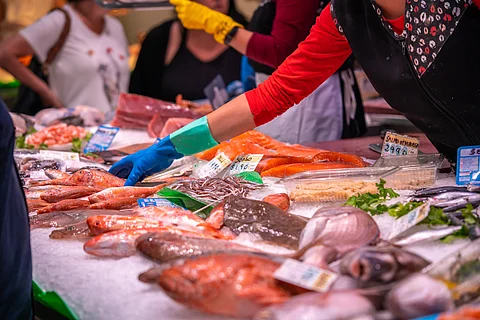

Fish market in Barcelona, Spain.
Photo: Adobe Stock.
The European Commission has released its annual EU Fish Market report for 2024, offering a detailed analysis of the performance of Europe's fisheries and aquaculture sectors over the years 2022–2023.
The report reveals a sharp decline in at-home fresh seafood consumption among EU households in 2023, reversing a positive trend observed during the pandemic years. Rising seafood prices, driven by economic and geopolitical instability, have significantly impacted consumers’ purchasing power. While household spending on fresh seafood rose by 6% in 2022, reflecting consistent price inflation since 2018, the actual quantity consumed fell to its lowest level in recent years.
This shift follows a period from 2019 to 2022 when fresh seafood consumption at home grew, largely due to reduced dining out during COVID-19 restrictions. However, the economic pressures of 2023 have now tipped the balance, making fresh seafood a less affordable option for many families, the report indicates.
The European country with the highest level of seafood consumption per capita was Portugal, reaching €456 worth of fishery and aquaculture productsper capita in 2023, more than three times the EU average of €138.
The figures indicate that tuna was the most-consumed species, followed closely by salmon. Shrimp came in third position, followed by Alaska pollock, cod, and mussels.
Chart showing the per capita expenditure on fish and aquaculture products in EU households in 2023, compared to 2022.
Source: European Commission Directorate-General for Maritime Affairs and Fisheries
The report also shows that the EU’s seafood trade faced challenges in 2023, with a decline in both value and volume compared to 2022. Total seafood trade value dropped by 2%, while the volume fell by 4%.
The EU imported seafood worth €30 billion in 2023, a 6% decline in value compared to 2022. Import volumes also dropped to 5.9 million tonnes, falling below pre-pandemic levels. Meanwhile, seafood exports from the EU also saw reductions in both value and volume.
The figures reflect broader economic challenges, including inflation, which have strained trade dynamics and reduced overall seafood activity within the EU, according to the report.
While overall consumption of fishery and aquaculture products decreased by 1% in 2022 compared to 2021, farmed seafood gained prominence.
Per capita consumption of aquaculture products reached 6.82 kilograms in 2022, the highest level recorded in a decade. Meanwhile, consumption of wild-caught seafood dropped to 16.70 kilograms per person, marking its lowest point in ten years.
The trend underscores a gradual shift towards aquaculture as a significant contributor to the EU seafood market, highlighting its growing role in meeting consumer demand and addressing supply chain challenges, according to the report.
The EU Fish Market report, published annually since 2014, is a flagship product of the European Market Observatory for Fisheries and Aquaculture Products (EUMOFA). This comprehensive analysis serves as a critical resource for policymakers, industry stakeholders, and other interested parties, offering insights into the challenges and opportunities shaping the EU fisheries and aquaculture sector.
